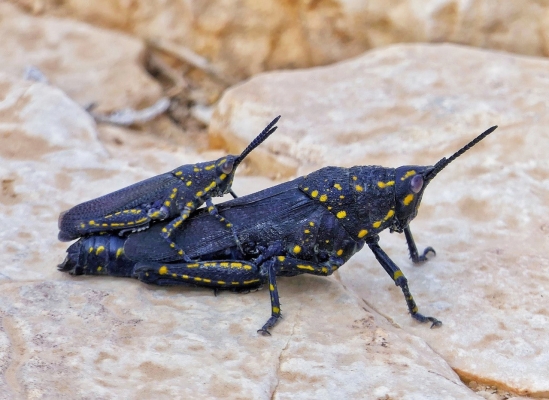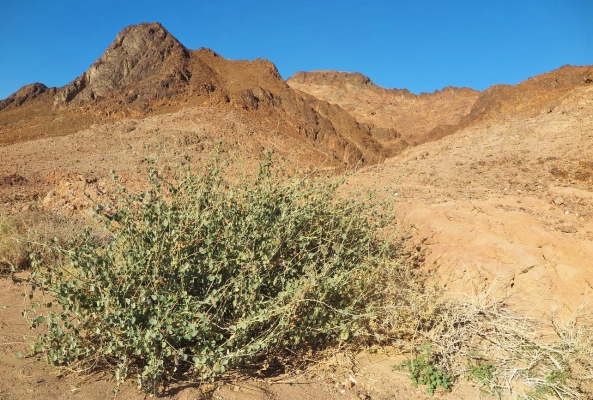Black Cone-Headed Grasshoppers...
...a Burst Water Pump and a Possible Case of Mental Telepathy
There is a peculiar Orthopteran that lives in Israel, mostly in the Rift Valley where it is almost always hot. The black cone-headed grasshopper (Poekilocerus bufonius) with bright yellow aposematic markings feeds only on plants of the milkweed family, Asclepiadaceae (or Apocynaceae). The sap of these plants is poisonous to many animals, containing alkaloids and cardiac glycosides; indeed, the sap of some genera in the family is used to poison arrows in Africa.
Female black cone-heads weigh about 5 grams and spend their time sucking sap from a variety of milkweed species; males weigh about 1 gram and, when not feeding, fly about in search of females. Black cone-headed grasshoppers have an abundant water supply in the plant sap they eat, and can evaporate excess water and maintain their body temperatures below ambient air temperature, even when it is, at least to us, very hot.
This interesting animal is what brought my friend and colleague of many years, Prof. Henry Prange, and his assistant, Chris Oswald, all the way from Indiana University in Bloomington to the Blaustein Institute for Desert Research (BIDR) of Ben Gurion University in the summer of 1992. Henry had received a grant from the National Geographic Society for us to study water balance and temperature regulation in black cone-headed grasshoppers, after he had spent several years studying these phenomena in other grasshopper species. He had asked whether I wished to collaborate in a study.
After my guests settled in, and we had organized the setup for our experiments in my laboratory, our next order of duty was to find and capture a reasonable sample size of these beasts, and to house and feed them in the lab. So, on a Friday morning, we set out at sunrise for Kibbutz Ein Gedi on the shores of the Dead Sea, about a two-hour drive from the small town of Midreshet Ben-Gurion (the Midrasha), where the BIDR is located and where my family live.
The Midrasha is 450 meters above sea level, whereas the area near Ein Gedi, where we planned to search for cone-heads on Sodom apple bushes (Calotropis procera) is almost 400 meters below sea level. We left early because the weather forecast was for a very hot day, and we took with us a more than adequate supply of water and vittles for breakfast and snacks, all in a cold box. It was a bit of a squeeze, the four us in our small family car, a 1300cc, five-door Opel Kadett with no air conditioner. Needless to say, the windows stayed wide open.
The drive down to the Dead Sea was magnificent. From the Midrasha, we drove north and east, bypassing the towns of Yeroham and Dimona, down the steep incline through the Judean Desert, from where we could see the Dead Sea (it was a little bigger back then), to the junction of road 25 with road 90 that runs from Eilat in the South, via Ein Gedi to Metulla in the very north of Israel. From the intersection we drove up the coast of the Dead Sea looking for appropriate plants. We drove all the way to Ein Gedi, searching for cone-heads on Sodom apple bushes in the wadis along the way.
Alas, by 9am we were still empty handed, and the temperature was already in the low 30s (°C) and increasing. So we decided to go home and try somewhere else in the following days.
We drove south and turned west onto road 25 to begin the 800m climb to Dimona. Somewhere over halfway up the 30 km road, a red light flashed on the dashboard and the car's temperature gauge pegged on the red end. I immediately pulled over onto the, fortunately very wide, verge. When we opened the hood, we found that the water pump had cracked, and we were immobilized; clearly, we needed to make a plan.
I should point out that road 25 was then part of the only traffic artery from Tel Aviv to Eilat and was, for the time, quite heavily trafficked by trucks and, especially on Fridays, tourists driving down to Eilat on the Red Sea. So it wasn't outrageous to think that if Henry and I stayed with the vehicle, Hana and Chris could hitch a ride to the gas station in Dimona, some 20 km up the road, where there was a payphone. From there, they could call the towing company with which our car was insured to take Henry, me, and the car to Beer Sheva, where my service garage was, 30 km west of Dimona. They could also call someone at the Midrasha to come and pick them up. I should also point out that at the time, it was considered perfectly safe to hitch rides in Israel. Unfortunately, that is not so today.
Hana and Chris put out their thumbs and pretty soon a large truck stopped and the driver offered them a ride to Dimona. So far so good. Henry and I opened the doors of the car, turned on the radio and, sitting in the shade, cooled by the breeze, we enjoyed the magnificent view. We could see a good part of the Dead Sea, from the pans of the saltworks at the south end to what was then Cape Molyneux, which no longer exists because the south end of the Dead Sea is now one big saltpan, mined by the Israelis on the west side and the Jordanians on the east.
After a while, I said to Henry, "You know, the only thing missing from this idyllic scene is cold beer". Henry leaned back with a sigh that said, "wishful thinking". Not two moments later, a car in the east-bound lane (towards the Rift Valley and Eilat) stopped by the side of the road opposite us. The driver rolled down his window and asked me whether I was Berry. I nodded and he put his hand out of the window holding a brown-paper bag. I got out of my car to take the bag and he said, "Your wife stopped me in the Dimona petrol station and asked me to give you this – enjoy" and drove off. In the bag were two cold bottles of Goldstar, a popular local lager. Were we ever surprised (and pleased)!
I popped the caps off in the catch of the door lock and we both leaned back to chill out and enjoy. Then, probably because I never drink beer in the middle of the day, a thought crossed my mind, "Henry, the last time we ate was pretty early this morning; maybe it's not such a good idea to drink on empty stomachs". Henry wasn't bothered one bit, but clearly, I was – and so it turned out was my better half, because no sooner had I voiced my thoughts to Henry, a second car pulled up opposite us.
The driver rolled down his window, stuck out his hand clutching a paper bag, and said, "Berry, your wife said not to drink beer on empty stomachs". In the bag were two large pittas filled with felafel, salad, humus and tehina, and two bottles of Tempo orangeade. For a moment I wasn't far from believing in telepathy. From time to time, I still wonder how Hana anticipates my thoughts. Henry was speechless, at least for a moment, and so was I.
We much enjoyed the felafel and the drink. A short time later, around noon, if my memory serves me right, the tow truck showed up. Hana and Chris had done us proud. The driver gingerly winched my Opel onto the back of the truck and secured it in place. The cabin of the tow truck was comfortable, air-conditioned and had a cold box of drinks between the seats. In relative luxury, off we drove to Beer Sheva.
Convinced as we were that Hana and Chris would manage to find someone at the Midrasha to come and pick them up, we weren't in the least worried that we might not find them at home when we got back. After all, we had to go to Beer Sheva and find a safe place to leave the car until Sunday. I should explain. At the time all businesses in Israel closed for the weekend at around midday on Friday; the weekend was just a day and a half. That has since changed and the weekend in Israel is Friday-Saturday. The big going-out evening is Thursday. Then back to work on Sunday morning.
So, I formulated a plan to park the car outside the house of my sister and her family who lived in Beer Sheva at the time, borrow their car for the weekend and come back to meet the tow truck early on Sunday morning. From there he would take me to the service garage. All that actually went down as planned. However, Hana and Chris were not home when we arrived at about 15:00. We had no idea where they were, and had no way to contact them.
Later, Hana told me what happened in Dimona. The truck driver let them off at a petrol station that had both a phone and a restaurant/snack and drink shop. She immediately called the tow company and gave them the details of our predicament. Then Hana set about calling friends at the Midrasha who might be able to help them; all the while thinking about Henry and me "suffering" at the car, and how to send us goodies, which she did with aplomb - twice. No ride was forthcoming.
The problem was that most of our acquaintances had taken their kids to visit grandparents for the short weekend, and whoever remained did not have a car. Luckily, in the end, one of our friends managed to contact the driver of a bus taking high school kitchen staff, who had ended their Friday shift, home to Dimona. He found Hana and Chris at the petrol station and brought them home, not much worse for wear, but with a story to tell.
A final note: we found the hoppers we needed a few days later on some milkweed bushes of a different species (Pergularia tomentosa) at a place much closer to home. We did the proposed study and closure came when our paper was published.









Comments